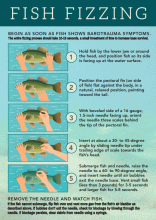Fishing deep during the winter can be a productive way to catch bass in highland reservoirs like Bull Shoals, Greers Ferry, or Norfork Lakes. However, whether targeting large schools of shad, deep-standing timber, or brush piles, anglers may catch a bass that needs to be “fizzed.” Below, we will explain the why and how of fish fizzing.
Generally speaking, research has shown that catching fish from depths greater than 25 or 30 feet can result in fish experiencing barotrauma. Barotrauma, commonly referred to as “the bends,” refers to injuries caused by changes in water pressure. If the water pressure change from deep water to the surface occurs too quickly, such as reeling in too fast, the fish may be unable to regulate its swim bladder, causing it to overinflate. As a result, a fish experiencing barotrauma may be unable to maintain proper orientation. In other words, the fish will float upside down or on its side while trying desperately to swim down but cannot do so.
How should you treat a bass experiencing barotrauma? First, we only recommend “fizzing” fish that cannot maintain proper orientation, as mentioned above. Next, we recommend treating the fish shortly after catching it using these instructions in the image to the left, to help avoid severe injury or death of the fish. Additionally, we made this video several years ago showing similar instructions. Finally, we do not recommend “fizzing” through the mouth, which is more likely to cause damage to vital organs or blood vessels, or using weighted fin clips to resolve barotrauma in fish.

